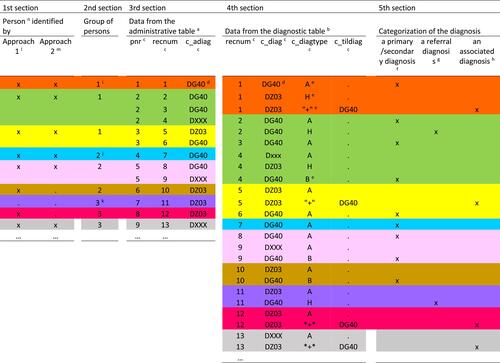Figures & data

Figure 1 Illustration of the data in the administrative table a(the 3rd section) and diagnostic table b(the 4th section) for 9 persons (each had a unique person’s identification number “pnr” and was marked with a color) including main variables c, diagnostic ICD codes d, and diagnostic types ein the Danish National Patient Registry using diagnosis of epilepsy as an example, and process in identifying patients with a diagnosis of epilepsy including categorization the diagnoses (a primary or secondary diagnosis f, a referral diagnosis g, and an associated diagnosis h) (the 5th section), groups of persons according to their diagnoses i, j, k (the 2nd section), and persons identified by approach 1l and 2m (the 1st section) n.

Table 1 Summary of Persons with a Hospital Contact Related to Neonatal Jaundice and Summary of Approach 1 and Approach 2 in Identifying Persons with a Diagnosis of Neonatal Jaundice Among the Study Population of Singletons Born Between 01 Jan 1997 and 30 Nov 1996 in Denmark (N=1,186,683)
Table 2 Summary of Persons with a Hospital Contact Related to Epilepsy and Summary of Approach 1 and Approach 2 in Identifying Persons with a Diagnosis of Epilepsy Among the Study Population of Singletons Born Between 01 Jan 1997 and 30 Nov 1996 in Denmark (N=1,183,273a)
